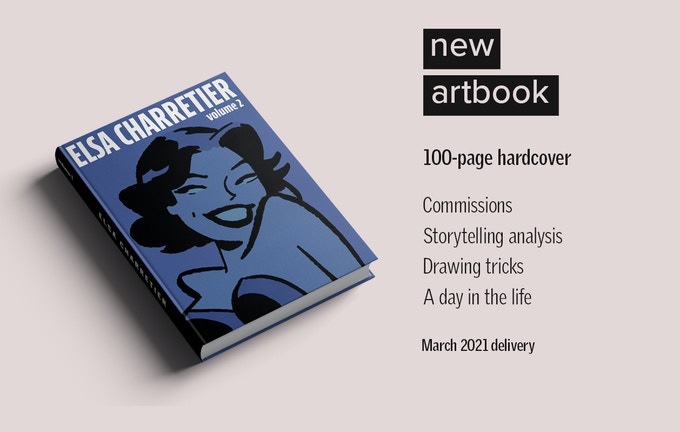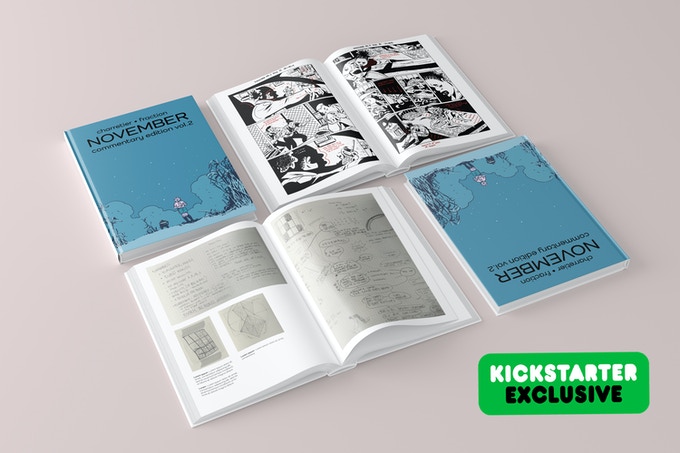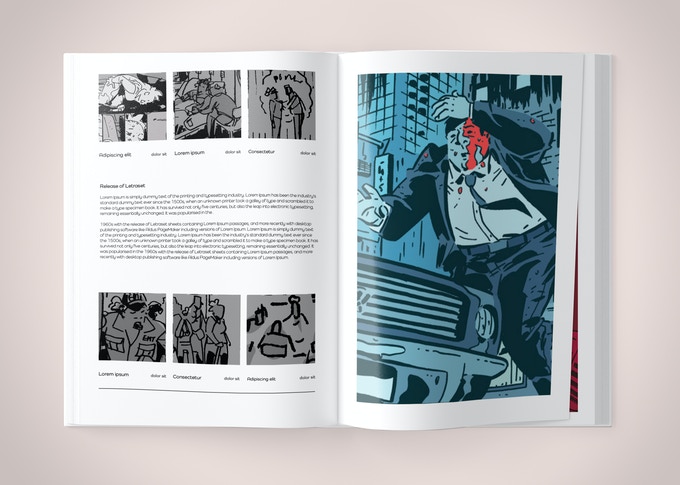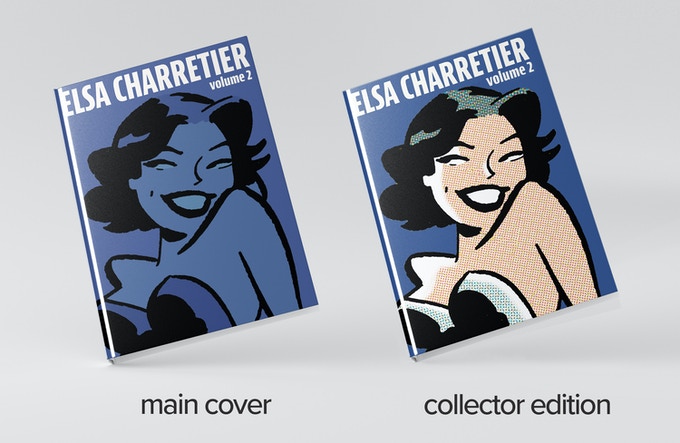“I Want to Offer Magic”: Elsa Charretier on Kickstarters, Artbooks and Embracing Passions
With a new volume of November on the horizon and her currently being Kickstarted artbook hitting six figures, artist Elsa Charretier is cooking right now. The story was similar earlier this year when we talked on Off Panel, but it feels like it’s taken to a new level with her current Kickstarter for a new artbook, attracting a ton of interest from fans both new and old. Even more exciting? It’s clear she’s embracing new approaches to bring her work to life in that project, with one of the best looking Kickstarters I’ve seen and some of the most inventive rewards and stretch goals in recent memory.
So naturally, I was excited to have the opportunity to chat with Elsa about this Kickstarter and everything that went into it. We made that happen over the past week, as we chatted about why she wanted to get back into the Kickstarter game, what she learned from her first effort, her love of learning, those aforementioned stretch goals and rewards, and a lot more.
It’s a good chat, and with this Kickstarter nearing its conclusion, I wanted to leave it open to anyone to read. So if you dig it, consider backing the Kickstarter and subscribing to SKTCHD!

This is your second artbook you’ve put together in almost exactly one year, with the second Kickstarter’s campaign set to conclude on, as near as I can tell, one year to the day from the first day of your last Kickstarter. What made you want to go down this path again? Was the first experience such a joy, or was it just that it was such a success? Or perhaps a bit of both?
Elsa Charretier: Definitely a bit of both. I don’t think you can replicate a success if you’re not having fun. What I love about crowdfunding is the ability to directly convey your enthusiasm about a project to potential backers. It’s a direct line to them.
I initially decided to do the first book because I had hurt my drawing hand which was a big bummer), and even though I couldn’t draw for a while, I needed to do something creative. The campaign and fulfillment ended up being the most joyous part of my year. For us, it’s the ability to create differently, to get out of our comfort zone, and to directly show how appreciative we are of people’s support.
And I find it’s the same thing this time around, with the added level that everyone is under a lot of stress and actually needs the relief from everyday life. We launched thinking we would probably not match the first campaign because of financial uncertainty for a lot of folks, but that was okay. It turns out it’s the absolute opposite: everyone showed up, and then some more!
A lot of artists like to have yearly artbooks where they share a look inside their process and what goes into their work, except they sell those at conventions. You’re delivering the same thing, except through Kickstarter and with a ton more depth, seemingly. What’s in the 2020 artbook, and how has the artbook experience you’re delivering changed on your second time through? Is it more of the same, or have you learned some things from your initial effort?
EC: From the beginning, my idea was to expand on the concept of the artbook as it’s usually done. If it is supposed to reflect an artist’s mind and creativity, I definitely felt that mine should include some deep look into the process. Because I love that stuff! I love talking about it, and hearing other artists talk about it. I also wanted to have fun putting the book together, playing with graphic-design, so I needed some interesting and varied content.
The overwhelming support and requests for more behind the scenes made me realize there’s really a place for such a book. The new volume builds up on that fondation, of basically being able to do whatever we want. It reflects where my career is going, freer and more independent. I’ve started doing grey scales illustrations, so that will be a new thing in the book, as well as more drawing tips (with QR codes leading to videos!) and an ever-closer look at my decision-making process.
For instance, I’ll be walking you guys along the creation of my Department of Truth guest issue. From day one, I’ll take notes and will detail the techniques I decide to go for, the storytelling approach I’ll use… I’m looking forward to that.
You seem particularly well suited to handling a Kickstarter. We talked about your packaging experience and how you wanted to not just put together a generic package, but something that looked nice and delivered a good experience for those that backed the Kickstarter. That’s fantastic, and can make a huge difference to backers as you lead into further projects. What did you learn from that first Kickstarter that you carried onto this new one, and how do you feel you’ve improved on the overall Kickstarter package you’re delivering?
EC: That’s where the true potential of Kickstarter is in my eyes: the ability to get backers an entire experience, not simply a product. From the campaign video, to the custom packaging we put together, I want to offer magic. I want people to get their packages and feel like it’s Christmas morning. It’s something my partner (Pierrick Colinet) and I think a lot about. When you get this much support, I think it’s the very least you can do.
The first campaign was exactly what it was: our first. We learned a lot, especially when it comes to fulfillment, and we’re now taking all that knowledge into a more ambitious project. What felt hard to deal with then, we can do our eyes closed now. Naturally this allows us more freedom and the abilities to go further. I don’t want to spoil anything when it comes to the packaging, because that’s part of the surprise effect (unless you’re that kid who hunted down hidden presents before Christmas…) but it’s going to be great.

You mentioned the QR codes leading to videos, which are actually a stretch goal you hit. One of several, actually, as you’re blowing through stretch goals at an incredible rate. One of my favorite elements of this campaign is one of the already reached stretch goals, which is how you’re getting Tom King to write one page of script, and then you and artist Declan Shalvey are having a “storytelling showdown.” It’s like a mini-exploration of Declan’s art cred idea, which I love! How did that aspect come together, and what exactly will it entail? Is it just showing the pages, or is it more of a breakdown?
EC: It is definitely an exploration of Declan’s brilliant idea.
Things are still a bit in the air as to exactly what will go in there and what the balance between pictures and text will be, but I welcome that. The chapter will evolve as we’re doing it and depending on what Tom and Declan suggest, but there will definitely be a breakdown component. The idea is not to say who’s the best (although we’ve had fun talking about this like a wrestling match), but to explain and compare why our paths to drawing the exact same script is different.
I already mentioned a couple guest stars on this effort, and I haven’t even mentioned Chip Zdarsky (whose role has yet to be revealed), Amy Reeder – one of your other stretch goal guests – and, most excitingly, Matt Fraction for the second volume of commentary on your graphic novella series, November. I wanted to talk about that aspect, because as Matt shared in his newsletter, taking us behind the scenes of how he does what he does is rare. You included commentary on November solely from your perspective before. What makes both you and Matt sharing details to your respective processes that much more special?
EC: Matt and I have talked about how November took shape in his head in the past. It’s such a fascinating process, so different from my own that I realized I couldn’t do another commentary edition without having his side. It’s not so much a list of writing does and don’ts, but a much more comprehensive look into his mind. How his past work and experiences influenced the book, how he drew on his childhood memories to build certain scenes… I’m actually discovering a great deal myself.
I love the comic con at home idea, which is rather genius, for all the reasons you laid out in the video teasing it. When it came to coming up with the stretch goals and rewards, what was your process for figuring out the right answers? Was it just mad brainstorming and seeing what made the cut, or did you have a pretty specific idea of what you wanted to do from the start?
EC: Some of them were stuff we had wanted to do for a while but the timing didn’t work out then. I had planned to do a Con at Home in June, but my deadlines became really too intense and I had to shelve the idea. When we started doing the Kickstarter, that felt a natural addition to the campaign so we went with it for a stretch goal (and I have to say the response has been great). I feel like we don’t have to think too hard about that sort of things luckily, it comes rather naturally. Then it’s figuring out if it’s actually doable! We have a lot of talks, day to day, about what we’re doing, what’s the next step, how can we fine tune this or that, and we rarely ever do actually brainstorming sessions where we actually sit down with a notepad. It’s a very free-flowing collaboration.

So much of this is built off of breaking down your own work and sharing how you do what you do, and you mentioned earlier how you love that kind of thing. What is it about exploring your work – and having others do the same – that appeals to you so much? Do you find that doing this kind of thing helps you make real gains with your work going forward?
EC: I’ve struggled with this for a long time, because I didn’t want it to seem like I was in love with my own stuff. To me, the whole idea of exploring my process, and others’, is to demystify the whole thing. To show that with just a few basic « rules » or guidelines, with experience, you can achieve a lot. Drawing isn’t hard, but on the other hand, it’s extremely hard, you know? And breaking stuff down reminds me that there is a logic in what we’re doing.
One thing that stands out about your Kickstarter above almost any other comic efforts I’ve seen are the aesthetics of it. Every aspect of it, from the images laying out reward tiers to the graphics for stretch goals feels very precisely you. Even the video you made teasing the Comic Con at Home stretch goal is perfectly cut and edited. I know one of the reasons you did the first artbook was because you wanted to learn InDesign. How much of these varying skills that this project asks of you are ones you learned specifically for this? And are you addicted to learning, because it seems like you’re always picking up new skills?!
EC: I am a little addicted to learning new skills, and Pierrick is too, so we’re bound to always throw ourselves into new creative avenues. My dad always used to complain that he could do a lot of things okay (like building houses, sailing, and overall fixing stuff) but he wasn’t excellent at anything. I’m more optimistic than he is, so I just took away the idea that it’s part of the development of a person to always be curious and look to improve your skills. And part of the DNA of our studio is that we are a one (or I guess two)-men band. Anything we want to develop, we’ve got to learn how to.
For this campaign I think we’ve made a big shift into video, and that’s going to drive what we do in the future as well. Pierrick’s first love is film-making, so he’s enjoyed stretching that muscle recently.
I mentioned Chip before, and it turns out the two of you are actually making a 14 page comic together as a stretch goal. Which is fantastic. I have to imagine given the nature of this project, this won’t strictly be a 14 page comic though. What does this comic entail, and is there a wrinkle to this comic that bring some sort of commentary or greater understanding to the reader? Or is it “just” a comic?
EC: I’m afraid it is « just » a comic! I’ve been wanting to work with Chip for a long time, and when it came to figuring out what would be the last stretch goal, we realized that we absolutely had to add significant value to the campaign. If we get this high, it means the campaign will have reached $140.000. This is mind boggling and I never, ever imagined we’d get this high. How do you thank people for following your work so faithfully? You can’t possibly get them a sticker. So, we settled on a second book. For free.

One thing that I thought was really smart for this campaign was adding a limited collector edition version of the artbook. It fits how much love comic fans love collecting things and it also gives potential backers a sense of urgency. I figured it’d go away quick. It…did. Where did that idea come from? Was it just trying to find an extra wrinkle to add to the mix, or was it something more specific?
EC: One thing we’re always very careful about is to not take advantage of fans. Not making a bunch of money exploiting their wish to get the rare and exclusive thing. Our collectors editions are at the exact same price as the main edition, but it is a little thank-you gesture to early, hard-core backers.
Two straight years doing this hardly makes for a trend, but it’s clear you enjoy each facet of this, as well as challenging yourself to learn new things. Do you see this as an every year kind of project, or does it all really depend on where the year takes you?
EC: I want this event to stay spontaneous. Even though they are almost exactly one year apart, the second volume was not planned ahead. I had just finished November, and was honestly a little sad our series was coming to an end, and I really needed something to lift up my spirit. A new artbook and a new Kickstarter felt right at that moment.
There will absolutely be future volumes (I’m having too much fun to stop) but I’ll only do them if, and when they feel right.
Did you enjoy this chat with artist Elsa Charretier? Would you like more content in this vein? Subscribe to SKTCHD today!
